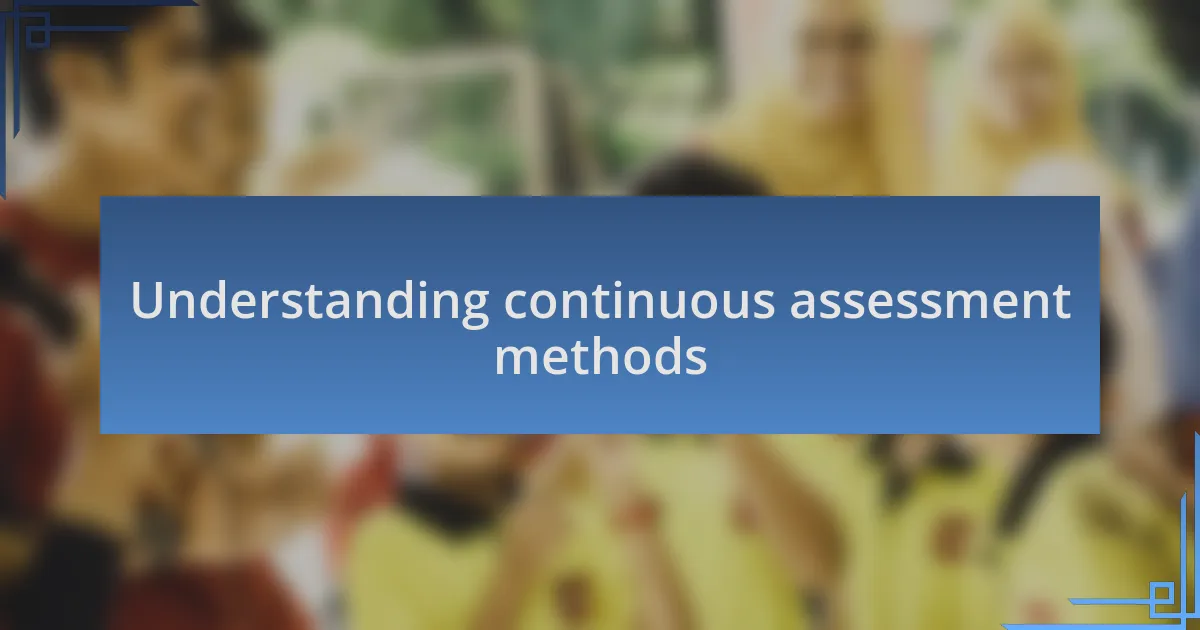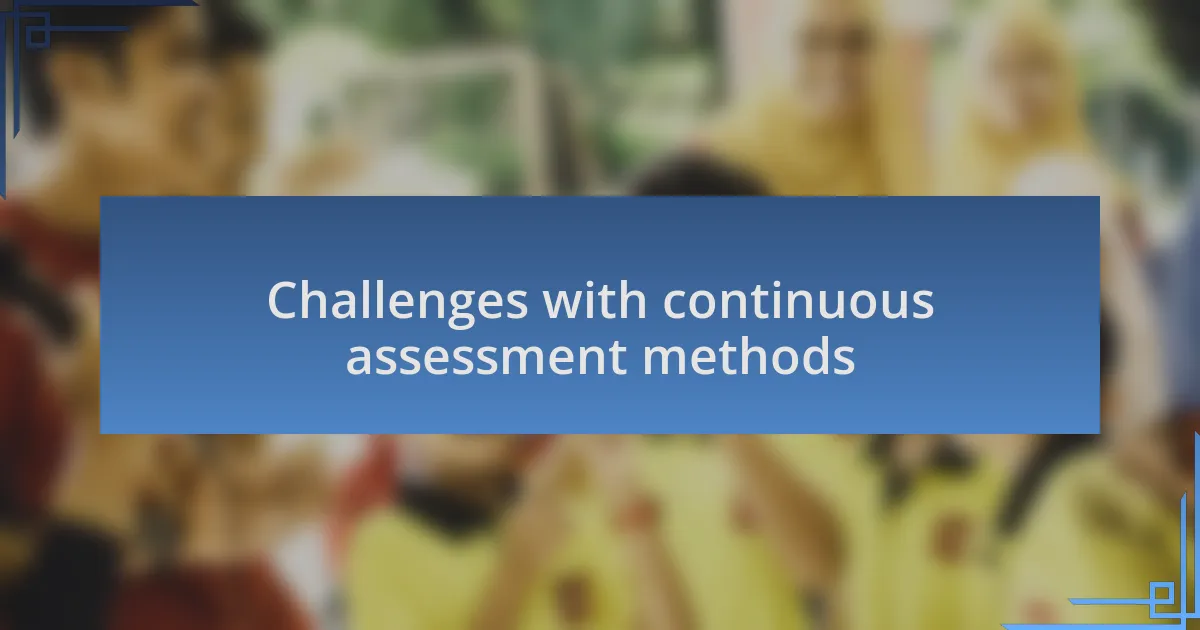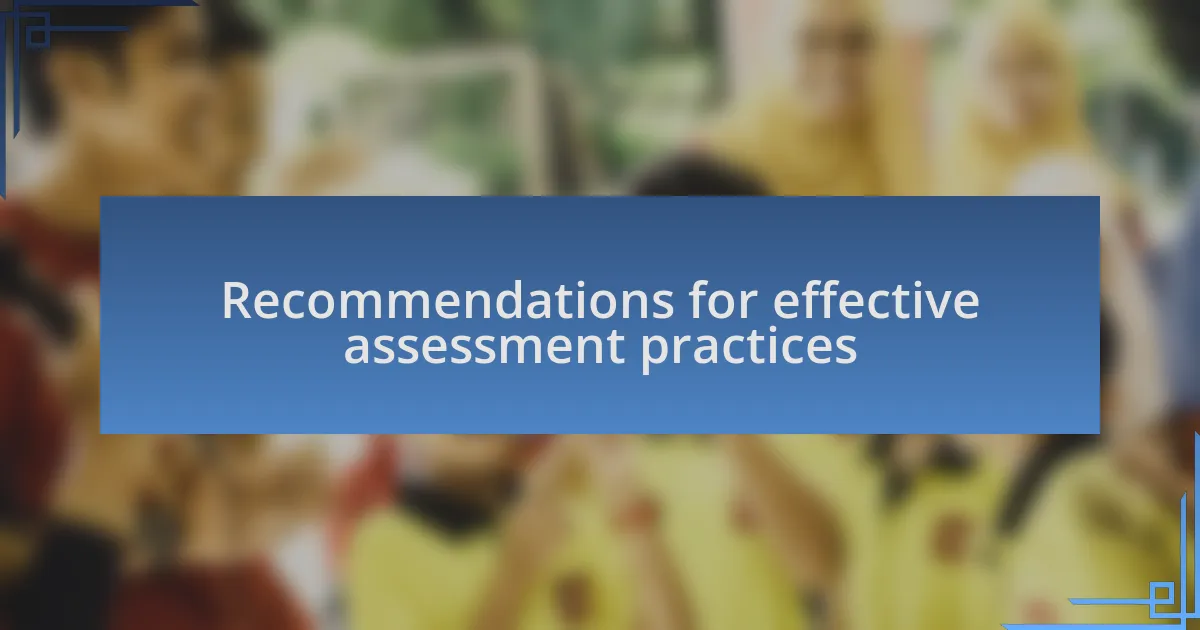Key takeaways:
- Continuous assessment methods promote a supportive learning environment by evaluating student progress over time, reducing anxiety associated with high-stakes exams.
- Formative assessments, portfolio assessments, and peer evaluations are effective strategies that enhance student engagement and foster reflection on learning.
- Challenges such as student anxiety, inconsistent assessment criteria, and time management require educators to find a balance between accountability and support.
- Incorporating diverse assessment formats and maintaining ongoing communication with students can empower them and address individual learning needs effectively.

Understanding continuous assessment methods
Continuous assessment methods are designed to evaluate students’ understanding and skills over time, rather than through a single, high-stakes exam. Imagine a scenario where a student grapples with challenging concepts in small doses rather than facing overwhelming assessments. Doesn’t it make sense that learning can be more meaningful when it’s a journey rather than a race?
In my experience, I’ve seen how these assessments can provide a clearer picture of a student’s progress. For instance, a young learner I worked with struggled initially but flourished when I incorporated regular feedback and informal quizzes into our sessions. This approach allowed the student to understand their learning gaps and celebrate small victories, which built their confidence.
Have you ever considered how continuous assessments could reduce anxiety? It opens up a dialogue between teachers and students, fostering a supportive learning environment. Instead of feeling judged by a final exam, students can view each assessment as part of their overall growth, leading to a more positive educational experience.

Types of continuous assessment methods
When it comes to continuous assessment methods, there are several types that can be incredibly effective. One common approach is formative assessments, which occur during the learning process. I recall using simple exit tickets where students jot down what they learned at the end of each class. This quick feedback loop not only helped me gauge their understanding but also empowered students to reflect on their own learning—a tool that often led to unexpected insights.
Another fascinating method is portfolio assessment, where students compile a collection of their work over time. Imagine a struggling student, initially hesitant about reading; I once watched a young learner blossom as they added their drawings and written pieces to a portfolio. This tangible representation of progress motivated them to push further, and the pride they felt was unmistakable. Can you see how this can transform a student’s mindset from viewing learning as a chore to celebrating their journey?
Additionally, peer assessments can be quite powerful, allowing students to evaluate each other’s work. I facilitated sessions where students provided constructive feedback on their classmates’ projects. Watching them engage in dialogue about their strengths and areas for improvement created a sense of community. Don’t you think this collaborative learning fosters deeper connections and enhances understanding?

Challenges with continuous assessment methods
Continuous assessment methods come with their own set of challenges that educators must navigate. I’ve noticed that one significant hurdle is the potential for anxiety among students. During a project where I implemented ongoing assessments, I observed that some learners felt overwhelmed by the constant expectation to perform. How can we create a supportive environment while still holding students accountable for their progress?
Another issue lies in the consistency of the assessments themselves. In one memorable class, I experimented with various assessment formats, but this inconsistency led to confusion. Students weren’t always clear on the criteria for success, which made it difficult for them to engage fully. Have you ever tried to hit a moving target? That’s how it can feel when assessment methods are constantly shifting.
Lastly, there is the challenge of time management. In my experience, continuous assessments require substantial time for both feedback and implementation. I vividly recall staying late after school to provide detailed comments on student portfolios, only to realize that balancing this with lesson planning was a constant juggling act. Is it possible to maintain high-quality assessments without sacrificing teaching time? It’s a tough question, but one that educators frequently grapple with.

My personal experiences with assessment
Throughout my teaching journey, I’ve had my fair share of experiences with different assessment methods. One time, I implemented a portfolio assessment with my students, hoping to provide a more holistic view of their learning. However, I soon realized that some of my students, especially those with dyslexia, struggled to showcase their abilities effectively, leading to feelings of frustration and inadequacy. Have you ever witnessed a bright student dim their light simply because they didn’t feel their assessment method suited them?
I remember a specific instance when I decided to use peer-assessment in my classroom. The idea was to encourage collaboration and critical thinking, but what I didn’t expect was the noise of anxiety in the room. Some students worried about being judged by their peers, which overshadowed the constructive feedback I hoped would emerge. It made me ponder: How can we create an environment where feedback feels safe rather than frightening?
Then there was the time I tried using online quizzes to streamline assessments. While I appreciated the immediate feedback they provided, I noticed some students, particularly those with dyslexia, had trouble with the format. Questions could seem misleading, and the timed nature of the quizzes often led them to rush and misinterpret what was being asked. Reflecting on this experience, I found myself asking: Can we truly measure learning if we don’t consider the individual needs of every student?

Recommendations for effective assessment practices
When considering effective assessment practices, I have often found that incorporating varied types of assessments can cater to diverse learning styles. For instance, I once created a project-based assessment where students could choose how to demonstrate their understanding. This flexibility allowed my students with dyslexia to shine in ways they hadn’t before, transforming their anxiety into enthusiasm. Have you ever considered how a simple choice in assessment format could create a remarkable difference in engagement and confidence?
Another important aspect I’ve learned is the necessity of ongoing communication with students about their assessments. In one class, I made it a point to hold individual check-ins with students after every major assessment. This practice turned out to be a game-changer, as it provided a safe space for students to express their concerns and understand their progress. I realized that when students feel heard, it not only alleviates their stress but also fosters a sense of ownership over their learning journey.
Finally, I advocate for the use of formative assessments, which can offer insights into student understanding without the pressure of grades. I remember implementing quick, informal check-ins during lessons, such as thumbs up or down for comprehension. This simple technique transformed the classroom atmosphere, allowing me to adjust my teaching on the fly. It made me reflect: How can regular, low-stakes assessments serve as a tool not just for the teacher, but also for building student confidence and resilience?